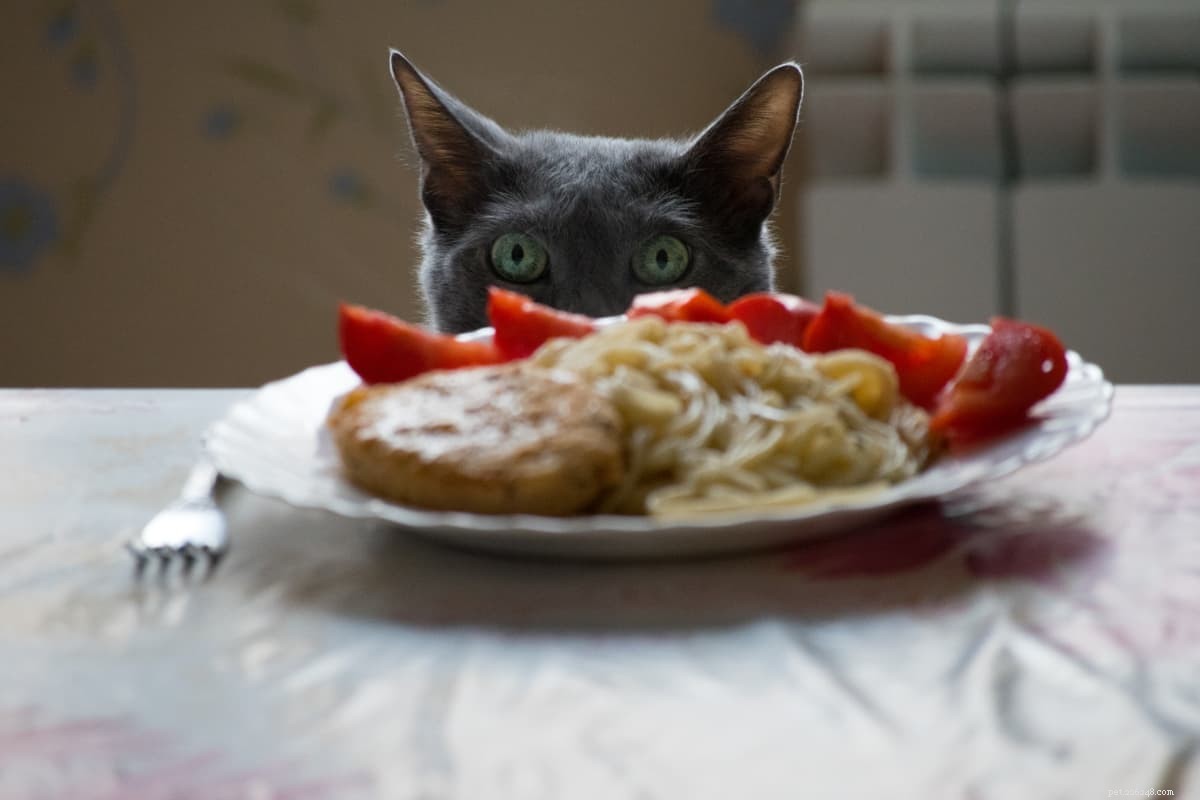
Katten zijn notoir kieskeurig. Veel katten zullen hun neus ophalen voor zelfs premium kattenvoermerken met een vleugje afkeer. Als je kieskeurige kat 'nee' zegt tegen commercieel voedsel, waarom zou je dan niet proberen om dingen op te fleuren met menselijk voedsel voor je kat?
Het dagelijks voeren van commercieel kattenvoer voor uw kat lijkt alledaags, niet alleen voor u, maar ook voor uw kieskeurige kat. Veel eigenaren van gezelschapsdieren maken zich oprecht zorgen over de ingrediënten en productieprocessen van overdreven bewerkte commerciële voedingsmiddelen. Natuurlijk voedsel is aantrekkelijker en smakelijker voor huisdieren. Maar welk voedsel voor mensen kunnen katten eten?Probeer de persoonlijke chef-kok van uw kat te worden. Geniet van maaltijdbereiding op maat met de volgende gezonde en natuurlijke voeding voor katten. Kitty's energieniveau zal toenemen en haar vacht zal er gezonder uitzien door de toegevoegde vitamines en mineralen.
Waarom zou u geen nieuwe lente in de tred van uw kat zetten en de smaakpapillen van de koppige kat prikkelen met de toevoeging van smakelijk en gezond voedsel voor mensen?
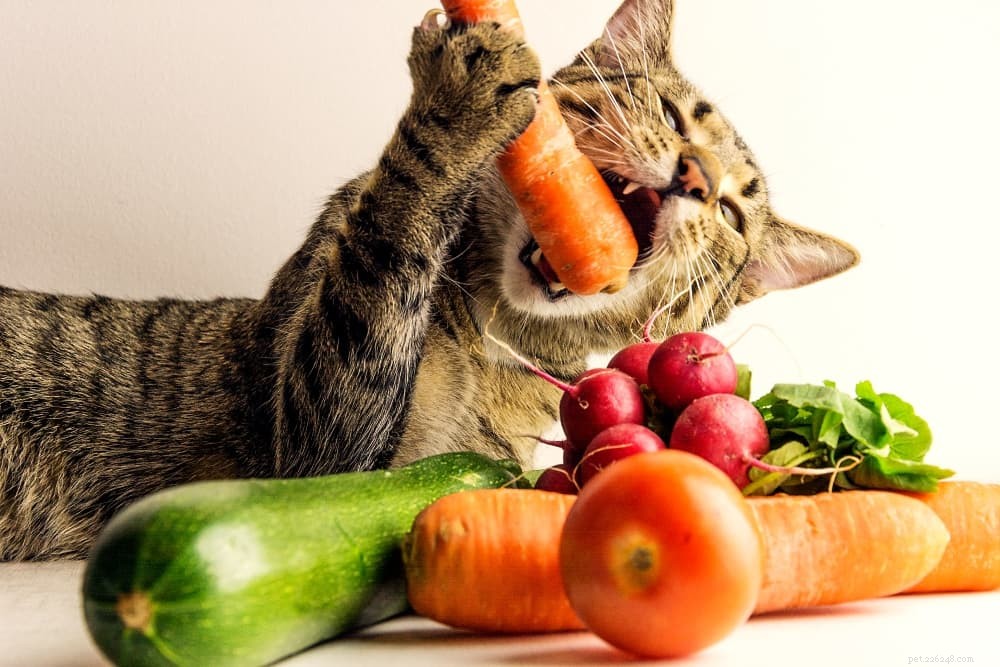
Ja, katten kunnen bepaalde groenten eten. Als je kamerplanten bezit, is de kans groot dat je je kat hebt betrapt op het kauwen op de bladeren. De meeste katten wenden zich tot groen ruwvoer in een natuurlijke poging om vezels aan hun dieet toe te voegen. U kunt de bladeren van uw kamerplanten vervangen (en de bladschade voorkomen) door het voer van uw kat aan te vullen met kleine porties katveilige groenten.
Katten zijn obligate carnivoren en hebben dierlijke eiwitten nodig voor een optimale gezondheid. Hun spijsverteringskanaal is aangepast voor de consumptie van vlees. Ze verteren overtollig plantmateriaal niet goed, maar hebben wel een bepaalde hoeveelheid ruwvoer nodig in hun voeding voor een optimale gezondheid, daarom grazen katten vaak op bladeren en gras.
Hoewel katten weinig behoefte hebben aan groenten in hun dagelijkse voeding, kunnen ze toch nuttig zijn als tussendoortje of als maaltijdtopper. Groenten bevatten prominente hoeveelheden vitamines en voedingsstoffen die de gezondheid van uw katten kunnen helpen verbeteren.
Het toevoegen van kleine hoeveelheden groenten aan het dieet van een kat met overgewicht kan nuttig zijn, omdat het hoge watergehalte en de vezels in groenten ervoor zorgen dat uw kat langer een vol gevoel heeft, wat de overmatige eetgewoonten van het huisdier en het hunkeren naar voedsel vermindert.
Probeer bij het kopen van groenten voor katten te kiezen voor biologisch, vrij van pesticiden. Was de groenten altijd grondig voordat je ze aan je harige vriend geeft. Hier zijn een paar groenten waar je kat van kan genieten:
Ja! Hoewel wortelen misschien niet de eerste groente zijn die je je kat denkt te voeren, kunnen ze een uitstekende snack zijn. Ze zitten boordevol bèta-caroteen, wat goed is voor de ogen en vacht van uw kat. Ze zijn ook een bron van vitamine E, kalium en vezels.
Wortelen kunnen een gezonde snack zijn, zolang ze met mate worden gevoerd. De natuurlijke suikers in wortelen kunnen bij katten spijsverteringsproblemen veroorzaken als ze te veel eten.
Hele of grote stukken ongekookte wortelen zijn erg hard. Als uw kat gewend is aan knapperige natuurlijke kauwsnacks, kunt u proberen uw kat een dunne reep wortel te geven om op te knabbelen, maar ze kunnen ook een verstikkingsgevaar opleveren als uw kat besluit een groot stuk door te slikken.
Soms. Hoewel witte aardappelen niet vol zitten met voedingsstoffen zoals andere groenten op onze lijst, zijn ze veilig om te eten als een zeer occasionele traktatie. Zorg er wel voor dat je alleen geschilde en gekookte aardappelen voedt. De schil van de aardappel en onrijp of ongekookt aardappelvlees bevatten een toxine dat solanine wordt genoemd.
Aardappelen zijn een veelgebruikt ingrediënt in kattenbrokjes, maar hebben niet veel voedingswaarde in vergelijking met andere kattenveilige groenten. Zoete aardappelen bieden daarentegen meer voedingsvoordelen dan witte aardappelen, zoals vitamine C, mangaan en antioxidanten. Ze bevatten ook zowel oplosbare als onoplosbare vezels, dus ze kunnen een effectief hulpmiddel zijn bij de spijsvertering als ze in kleine hoeveelheden worden gevoerd.
Hoewel ze een populair bijgerecht zijn voor onze maaltijden, zijn veel van de manieren waarop we aardappelen eten niet goed voor katten. Kruiden, zoals zout of knoflook, is niet veilig voor katten, dus tenzij je je aardappelen flauw eet, moet je ze niet delen.
Kunnen katten frietjes eten? Zeker niet. Frieten zijn gefrituurd, wat betekent dat ze tijdens het koken oliën opnemen en spijsverteringsproblemen bij katten kunnen veroorzaken. Bovendien zijn frieten erg zout, wat gevaarlijk is in voldoende grote hoeveelheden.
Dus geen friet, maar hoe zit het met chips? Mogen katten chips eten? Sorry, maar nog steeds niet. Net als friet zijn chips gefrituurd en zwaar gekruid, waardoor ze ongezond en mogelijk giftig zijn voor katten.
Ik weet het, ik weet het, tomaten zijn technisch gezien een vrucht, maar we gebruiken tomaten vaak als groente, net zoals we doen met komkommer en aubergine (ook botanisch fruit) dus het is op onze vegetarische lijst. Ga ermee om.
Mogen katten tomaten eten? Dat kan, maar alleen op bepaalde onderdelen. Net als aardappelen zijn alleen bepaalde delen van de tomatenplant veilig. De stengel en de bladeren bevatten beide solanine, dezelfde stof in aardappelen die giftig is voor uw kat. Onrijpe of groene tomaten bevatten ook veel solanine. Alleen het rijpe vruchtvlees van de tomaat is veilig.
Tomaten zitten boordevol vitamine C en kalium, evenals een krachtige antioxidant, lycopeen genaamd, die oxidatieve celbeschadiging helpt voorkomen. Tomaat biedt ook gezonde vezels om de spijsvertering van uw kat te ondersteunen.
Tomaten zijn misschien een veilige traktatie, veel populaire voedingsmiddelen en specerijen gemaakt met tomaten zijn dat niet. Mogen katten ketchup, pastasaus of tomatensoep eten? Nee tegen allemaal. Deze producten bevatten suikers en kruiden die schadelijk zijn of spijsverteringsproblemen kunnen veroorzaken bij katten.
Absoluut! Broccoli bevat vitamine K en calcium, die beide belangrijk zijn voor de gezondheid van het skelet van uw kat. Het is ook een nuttige bron van fosfor, zink en vitamine A. Groenten zijn meestal een slechte bron van zink. Daarom zullen complete kattenvoedingsdiëten zink uit vlees, eieren en peulvruchten halen, maar broccoli kan de zinkniveaus een beetje helpen bufferen beetje.
Broccoli kan rauw worden gevoerd, maar houd er rekening mee dat de stelen hard zijn en moeilijk verteerbaar kunnen zijn. Rauwe, harde stengels moeten worden gepureerd of zeer fijn in blokjes gesneden. Door de broccoli te koken of te stomen, worden de stelen zachter, sla de toppings gewoon over, zoals boter en zout. Zachte, gekookte broccoli is veilig om te voeren in in blokjes gesneden, hapklare brokken.
Dat kunnen ze zeker! Komkommer is een caloriearme krachtpatser van voedingsstoffen, die vitamine C en K en magnesium bevat. Ondanks de veelheid aan video's van katten die gek zijn op komkommers, zijn ze een geschikte en veilige traktatie voor uw kat.
De vezels en hoge waterconcentraties in komkommer maken ze tot een geweldige caloriearme traktatie voor mollige katten. Ze kunnen uw kat een verzadigd gevoel geven en het verlangen naar voedsel verminderen, en extra vocht helpt zowel de spijsvertering als de urinewegen te ondersteunen.
Kunnen katten augurken eten? Zeker niet! Pickles worden gefermenteerd in pekel of azijn. Hoe dan ook, deze zijn slecht voor katten en veroorzaken waarschijnlijk spijsverteringsproblemen. Het zout en de kruiden die worden gebruikt, kunnen zeer gevaarlijk zijn voor katten, dus deze smakelijke menselijke snack moet uw kat vermijden.
We raden het aan! Een andere "vegetarische" die technisch gezien een vrucht is, pompoen zit boordevol bètacaroteen en vitamine A, C en E, maar het grootste voordeel van pompoen zijn de vezels. Pompoenvlees is een mengsel van oplosbare en onoplosbare vezels, wat betekent dat het zowel bulkt als water opneemt.
Katten met een gevoelige spijsvertering hebben baat bij de pompoen in hun dieet, omdat het kan helpen bij zowel diarree als constipatie. Pompoen wordt gebruikt in veel commercieel kattenvoer, maar kan ook preventief worden gebruikt of als een snelle remedie voor plotselinge spijsverteringsproblemen. Voor een gemakkelijke voedingsoptie, bekijk Nummy Tum Tum Organic Pumpkin Puree.
Hoe zit het met de zaden? Kunnen katten pompoenpitten eten? Het zal je misschien verbazen dat katten pompoenpitten kunnen eten en er echt van kunnen genieten! De zaden bevatten veel omega-3-vetzuren die de huid + vacht, het immuunsysteem en de spijsvertering kunnen ondersteunen.
Rauwe zaden bevatten fytinezuur, dat het vermogen van uw kat om voedingsstoffen op te nemen kan verminderen. Om het fytinezuur af te breken, moeten de zaden ofwel een nacht worden geweekt of gekookt. Ga voor stapsgewijze instructies voor het weken van je zaden naar Perfectly Rawsome.
Als de groenten in onze top 5 lijst je kat niet enthousiast maken, maak je dan geen zorgen, er zijn nog veel meer kattenveilige groenten die je kunt gebruiken poging. Vergeet niet dat alle groenten met mate moeten worden gevoerd met volledig en uitgebalanceerd kattenvoer.
Hoewel er veel kattenveilige groenten zijn, hebben katten niet veel plantaardige inhoud nodig in hun totale dieet. Compleet en uitgebalanceerd kattenvoer zal alle essentiële voedingsstoffen leveren die uw kat nodig heeft, wat betekent dat eventuele extra groenten met mate moeten worden gevoerd om overvoeding van bepaalde voedingsstoffen te voorkomen.
Eén keer per week één portie van één tot twee eetlepels groenten voeren is voldoende. Hierdoor kun je verse voedselingrediënten aanbieden zonder te overdrijven.
Alle cellen in groenten hebben een onverteerbare buitenlaag van cellulose. Daarom is het aan te raden om deze laag af te breken door de groenten te stomen, waardoor ze gemakkelijker verteerbaar worden. Door de groenten te koken, worden ze ook zachter, zodat ze smakelijker zijn voor uw kat.
Koken kan echter leiden tot verlies van voedingsstoffen, dus een goede manier om groenten rauw te voeren, is door ze in je keukenmachine te gooien en ze te pureren. Hierdoor zijn ze makkelijk te gebruiken als maaltijdtopper.
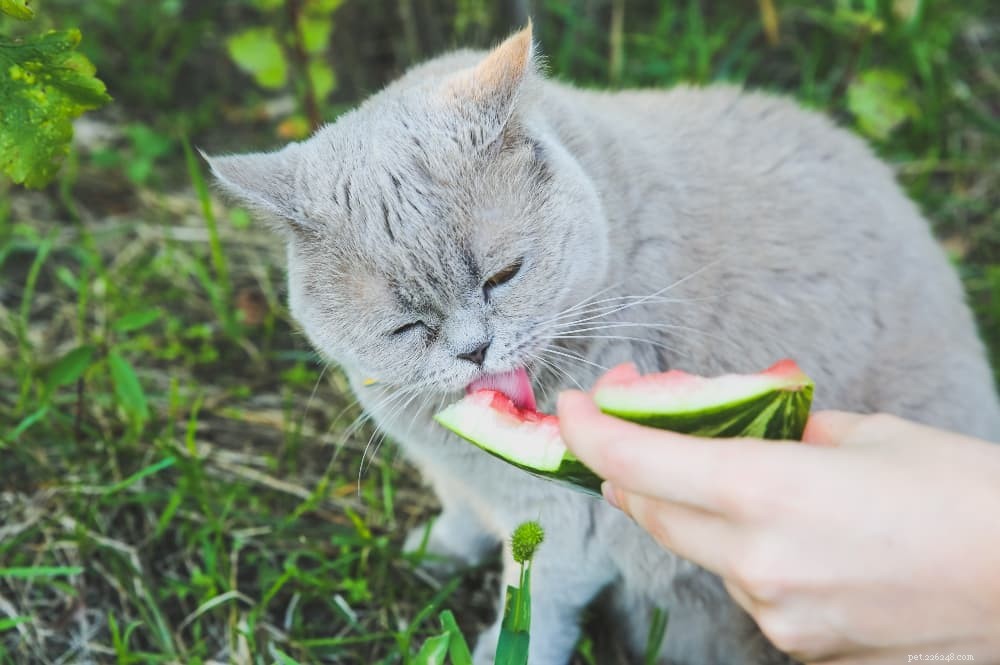
We weten dat fruit vol zit met vitamines en andere heilzame voedingsstoffen, maar als carnivoren hebben katten heel weinig behoefte aan fruit in hun dieet. Toch betekent dat niet dat het af en toe behandelen van uw huisdier met kattenveilig fruit nog steeds gunstig kan zijn.
Kleurrijk en levendig fruit kan natuurlijke bronnen van bètacaroteen, in water oplosbare vitamines en vezels bieden, maar ze bevatten ook van nature veel fruitsuikers. Met een beetje kom je een heel eind als het om fruit gaat, en fruit zou maar een heel klein deel van het dieet van je kat moeten zijn, ongeveer 1% of minder.
Dit kan het behandelen van uw kat met fruit een uitdaging maken, maar als u weet welk fruit veilig en heilzaam is voor uw katten, kunt u manieren vinden om uw kat af en toe wat verse en heerlijke fruitige snacks aan te bieden.
Veel fruit is veilig voor katten en omdat we ons fruit rauw en vers eten, is het een van de gemakkelijkere snacks om met onze huisdieren te delen. Maar alleen omdat katten fruit kunnen eten, wil nog niet zeggen dat ze dat ook zouden moeten doen. Ontdek welke vruchten veilig zijn voor katten en hoeveel van elk veilig is om te voeren.
O ja! Bananen zijn een geweldige bron van vezels en kalium, en kunnen in kleine porties een nuttig hulpmiddel zijn bij de spijsvertering voor katten, maar het hoge suikergehalte in bananen betekent dat ze meer problemen kunnen veroorzaken dan ze oplossen als je te veel voedt. Probeer een tot twee porties per week niet te overschrijden.
Katten zijn erg tactiele eters, en daarom zijn bananen niet een van de vruchten waar katten zich over het algemeen op aangetrokken voelen. De papperige textuur kan onaangenaam zijn voor katten, dus veel geluk om ze een stuk banaan te laten eten zoals het is. Misschien heb je meer geluk door de banaan te mengen met meer gewenste smaken of texturen om het fruit te maskeren.
Wat de voorbereiding betreft, is de schil van de banaan niet giftig, maar het kan verstikkingsgevaar opleveren en een maagklachten veroorzaken. Bananenschil is erg moeilijk te verteren, dus het is waarschijnlijker dat het problemen veroorzaakt, zelfs als je kat erop kan kauwen.
Ja, dat kan! Aardbeien zijn niet alleen rijk aan antioxidanten, maar bevatten ook vitamine C, mangaan en kalium. Helaas bevatten aardbeien ook veel natuurlijke fruitsuikers, dus het voeren van grote hoeveelheden kan leiden tot spijsverteringsproblemen.
Zorg ervoor dat je alle bladeren of stengels verwijdert, omdat deze huidirritatie kunnen veroorzaken vanwege de gekartelde vorm van de bladeren. Hak of pureer de aardbeien en voeg de bessen toe aan de volgende maaltijd van uw huisdier.
Aardbeien zijn trouwens niet de enige kattenveilige bes. Mogen katten bosbessen eten? Hoe zit het met frambozen, veenbessen of bramen? Veel bessen zijn veilig voor katten en zitten boordevol vitamines en antioxidanten die de gezondheid van uw kat kunnen verbeteren.
Venbessen zijn bijvoorbeeld een nuttige aanvulling ter ondersteuning van de gezondheid van de urinewegen bij katten. Cranberrypoeder, zoals Cranimals, is een gemakkelijke manier om cranberry aan de maaltijden van uw kat toe te voegen. Cranberry wordt ook vaak gebruikt in kattensnoepjes met urine, zoals deze van Emerald Pet.
Bessen moeten worden gewassen en gehakt, gepureerd of gepureerd om de verteerbaarheid en opname van voedingsstoffen te vergroten. Vanwege hun suikerachtige en zure aard moeten bessen met mate worden gevoerd en vermijd altijd zoete fruitmengsels zoals jam, gelei of taartvulling.
natuurlijk! Het zal je misschien verbazen dat watermeloen eigenlijk een van de meest populaire vruchten voor katten is. Hoewel het voor ons een zoete traktatie is, houden katten van de textuur van verse meloen, dus het kan zijn dat je kat smeekt om een smaakje de volgende keer dat je een seizoensmeloen openbreekt.
Watermeloenen bevatten 90% vocht, dus ze zijn een geweldige optie om je kat goed gehydrateerd te houden. Watermeloen is van nature ook rijk aan vitamine C en antioxidanten, maar ook aan natuurlijke fruitsuikers. Het maakt niet uit hoe graag je kat een beetje van je meloen verlangt, blijf bij kleine porties om spijsverteringsproblemen te voorkomen.
Andere soorten meloen zijn ook kattenveilig. Mogen katten meloen of honingdauw eten? Net als watermeloenen zijn ze in kleine porties veilig voor katten. Zorg er bij alle meloenen voor dat alle schil of zaadjes verwijderd zijn en voer alleen rijp meloenvlees.
Yup! Appels zijn veilig voor katten om te consumeren, maar alleen als ze geschild en klokhuis zijn. De schil is moeilijk te verteren, maar de zaden in de kern bevatten amygdaline, dat cyanide bevat. Zelfs kleine hoeveelheden cyanide kunnen extreem gevaarlijk zijn voor katten, dus zorg ervoor dat je de hele kern verwijdert.
Apple bevat veel fruitsuikers, terwijl dit in grote doses slecht kan zijn en kan leiden tot een verstoorde kattenbuik. Appels bevatten ook een oplosbare vezel, pectine genaamd. In kleine hoeveelheden kan pectine de spijsvertering helpen ondersteunen door de gezonde bacteriën in de darm van uw kat te voeden.
Kunnen katten appelmoes eten? We raden aan om de meeste vruchten te pureren om de verteerbaarheid te maximaliseren, dus appelmoes lijkt een ideale optie. Maar wees heel voorzichtig om de ingrediëntenlijst op voorverpakte appelmoes te controleren. Extra suikers of conserveermiddelen worden vaak gebruikt en zijn niet veilig voor katten.
Kunnen katten appeltaart eten? Zeker niet! Het zijn de extra ingrediënten die voedsel op basis van appel onveilig maken voor katten, en dat geldt ook voor appeltaart. De suikers, kruiden en korst kunnen ongezond of gewoon giftig zijn voor katten.
Ja, katten kunnen veilig avocado's eten en velen genieten er zelfs van. Voer slechts kleine hoeveelheden van het vlees. Geef de schil of het zaad niet aan een kat. De schil en pit van een avocado bevatten een persoon, die giftig is voor honden en katten.
Avocado's zijn rijk aan vet, vitamine E, A en B6 plus aminozuren. Ze kunnen de vacht en huid van uw kat helpen verbeteren. Sommige katten hebben echter een gevoelige maag die mogelijk niet goed reageert op het hoge vetgehalte in avocado's en het risico van het dier op het ontwikkelen van alvleesklierontsteking zou kunnen vergroten, dus blijf bij kleine, zeldzame porties.
Kunnen katten guacamole eten? Hoewel avocadovlees veilig is, is ons favoriete avocadogerecht, guacamole, dat niet. De limoen, het zout en de knoflook zijn schadelijk voor uw kat, dus zorg ervoor dat u zich alleen aan gewoon, ongekruid avocadovlees houdt.
Zoals eerder vermeld, zou fruit slechts een heel klein deel van het dieet van uw kat moeten zijn, dus het maakt niet uit van welk katveilig fruit uw kat houdt, wees zeer voorzichtig met hoeveel en hoe vaak u ze voedt. Een tot twee theelepels gepureerd fruit per week is veel voor een vleesetende kat.
Een goede regel om te volgen is dat fruit moet worden geschild, geboord en alle schillen, bladeren, pitten en stengels moeten worden verwijderd. Het vruchtvlees is het enige deel dat ooit aan uw kat moet worden gevoerd. Zacht fruit, zoals frambozen, kan in hapklare stukjes worden gehakt en gevoerd, maar net als groenten zal al het fruit beter verteren als het wordt gepureerd.
Een ander ding om in gedachten te houden is dat uw kat misschien niet geïnteresseerd is in fruit. Ze hebben geen voorkeur voor zoete smaken, dus kieskeurige katten halen hun neus op voor vers fruit of fruitpuree. Laat uw kat het fruit altijd proberen voordat u het aan haar maaltijd toevoegt, omdat ze het misschien niet wil eten.
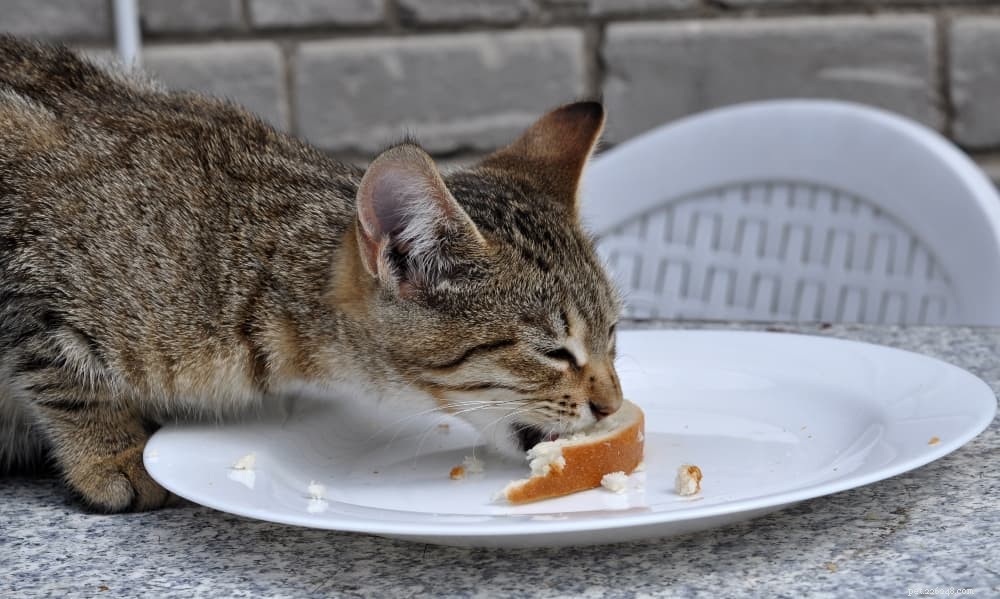
Veel eigenaren van gezelschapsdieren vragen zich af wanneer ze het ontbijt bereiden:"Kunnen katten havermout eten?" Ja, katten kunnen hele of ongeraffineerde granen eten, maar geraffineerde granen missen de voedingswaarde van volle granen die boordevol ijzer, vezels en vitamines zitten.
Net als groenten hebben katten geen granen nodig in hun dieet, maar dat betekent niet dat ze geen voedingswaarde hebben. Veel volkoren granen bevatten vitamines, mineralen en nuttige vezels om de spijsvertering te ondersteunen.
In het ideale geval zouden granen niet meer dan 5 tot 10 procent van het dieet van een kat moeten uitmaken. Dit is vergelijkbaar met wat een wilde kat zou eten, hetzij door te grazen op grassen en ander plantaardig materiaal, hetzij uit de maag en de spijsvertering van de wilde prooi die ze consumeren.
Er zijn veel redenen om granen te voeren die vol zitten met vitamines, ijzer en vezels voor een optimale voedingswaarde. Zelfs de gezondste granen moeten met mate worden gevoerd, vooral als uw kat al een dieet eet dat rijk is aan koolhydraten. Granen als traktatie kunnen het beste worden gebruikt als een bron van vezels om de spijsvertering te ondersteunen, of als ingrediënt in gebakken of zelfgemaakte kattensnacks.
Dat kan! Rijst is een van de meest gebruikte granen in kattenvoer. Het is rijk aan voedingsvezels en is een goedkoop ingrediënt voor de brokjes van uw kat. Hoewel het misschien veilig is voor katten, wordt rijst vaak te veel gebruikt in voedsel voor huisdieren, dus je moet vermijden meer rijst te voeren als je kat al een koolhydraatrijk dieet eet, zoals brokken.
Hoewel het geen geweldige traktatie is, kan het deel uitmaken van een nuttig zelfgemaakt dieet voor kleine spijsverteringsstoornissen bij huisdieren. Een neutraal dieet, zoals Grandma Lucy's Simple Replacements, dat meestal bestaat uit gekookte rijst en gekookte kip, kan een paar dagen worden gevoerd om uw kat te helpen over een aanval van diarree heen te komen.
Witte rijst biedt beperkte voeding, behalve vezels, maar bruine rijst kan worden vervangen als een lagere glycemische optie om bloedsuikerpieken te verminderen en uw kat een een vol gevoel hebben als ze op dieet zijn.
Technisch gezien wel, maar dat zou niet moeten. Hoewel tarwe het hoofdingrediënt is in veel van onze favoriete koolhydraten, staat geraffineerde tarwe erg hoog op de glycemische schaal en is het niet geweldig voor katten. Volkoren tarwe is beter, maar het zal je kat nog steeds niets anders bieden dan dat ze niet kunnen krijgen van verse dierlijke eiwitten en sommige groenten.
Dit betekent dat brood en ander voedsel op basis van meel, hoewel niet giftig, slechts een heleboel lege calorieën zijn. Hoewel ze misschien een goed tussendoortje zijn, is er veel beter en voedzamer voedsel voor uw kat.
Alternatieve meelsoorten, zoals amandel of kokosnoot, zijn ook veilig voor katten en hebben een lage glycemische waarde, maar bevatten veel vetten, dus moeten worden beperkt tot een alleen af en toe een traktatie.
Absoluut! Haver zit boordevol oplosbare vezels en antioxidanten. Ze zijn ook lager glycemisch dan veel andere populaire granen, maar zijn het beste in hun volkoren en minimaal verwerkte vorm. Staal gesneden haver is de ideale optie.
Dit betekent dat je instant havermout in de ochtend waarschijnlijk niet de beste optie is. De pakketten zijn vaak gearomatiseerd of gezoet, wat spijsverteringsproblemen bij katten zal veroorzaken. Als je thuis je eigen staal gesneden haver maakt, houd dan een klein deel zonder zoetstoffen of kruiden apart voor je kat en laat het volledig afkoelen voordat je het serveert.
Absoluut! Ok, dus technisch gezien is quinoa een zaadje, geen graan, maar het wordt gegeten als een graan. Quinoa is een van de meest onderschatte koolhydraten voor huisdieren. Het is het enige graan dat als een compleet eiwit wordt beschouwd, wat betekent dat het alle essentiële aminozuren bevat die katten nodig hebben, behalve één - taurine.
Het is ook laag glycemisch, dus het is een betere optie om in het normale dieet van uw kat op te nemen dan de granen op onze lijst. Het bevat veel eiwitten en vezels en biedt vitamines en mineralen zoals mangaan, fosfor en B-vitamines.
Als het zo geweldig is, waarom is het dan niet populairder in kattenvoer? Zoals de meeste dingen, komt het neer op prijs en beschikbaarheid. Granen zoals maïs, haver en rijst zijn veel kosteneffectiever, dus ze hebben de voorkeur van de huisdierenindustrie.
Misschien. Deze is op zijn zachtst gezegd controversieel. Maïs krijgt een slechte naam in de huisdierenindustrie, en hoewel veel van de zorgen volkomen terecht zijn, is maïs niet giftig voor katten. Katten hebben geen voedingsbehoefte aan maïs. It's not the best ingredient to include as a regular part of your cat's diet, but a little as a treat, it is safe, and contrary to popular belief, does actually offer some important nutrients.
Despite its high glycemic effects, corn is a source of vitamin C, protein, and fibre, which is why it's a common ingredient in pet food. The nutrients in corn may be sound appealing as a diet booster, but there are better sources of these nutrients in meat, vegetables, and fish, all of which are easier to digest.
Another thing to consider, and one of the reasons that corn is not a preferred cat food ingredient is the high risk of mycotoxins. Mycotoxins are produced by fungus and mould spores and are very common in corn crops.
Feed producers need to have stringent regulations and procedures to minimize and manage mycotoxin-infected crops. While these regulations reduce the risk, mycotoxins can still be a risk when feeding corn products to your pet.
Feed all grains in moderation. Grains are best fed cooked to soften them. Hard grains like rice or corn will be difficult to digest, and even soft grains like oats will break down faster if they are cooked or at least hydrated. Feed only a tablespoon once or twice a week, at most.
Use grains sparingly and only as treats or meal toppers rather than a regular addition to your pet's daily meals. While whole grains are safe for cats to eat, the majority of your cat's nutrients should come from animal proteins.
If you are looking for a healthy and popular way to use grains to treat your cat, try different types of cat grass, like barley grass, ryegrass, or oat grass like in the Catit Senses 2.0 Cat Grass Kit. These offer some soluble fibre, vitamins and minerals, and can help improve your cat's digestion when fed as an occasional treat.
If you are already feeding a kibble diet or a diet high in carbs, then skipping grains as treats altogether is the best practice.
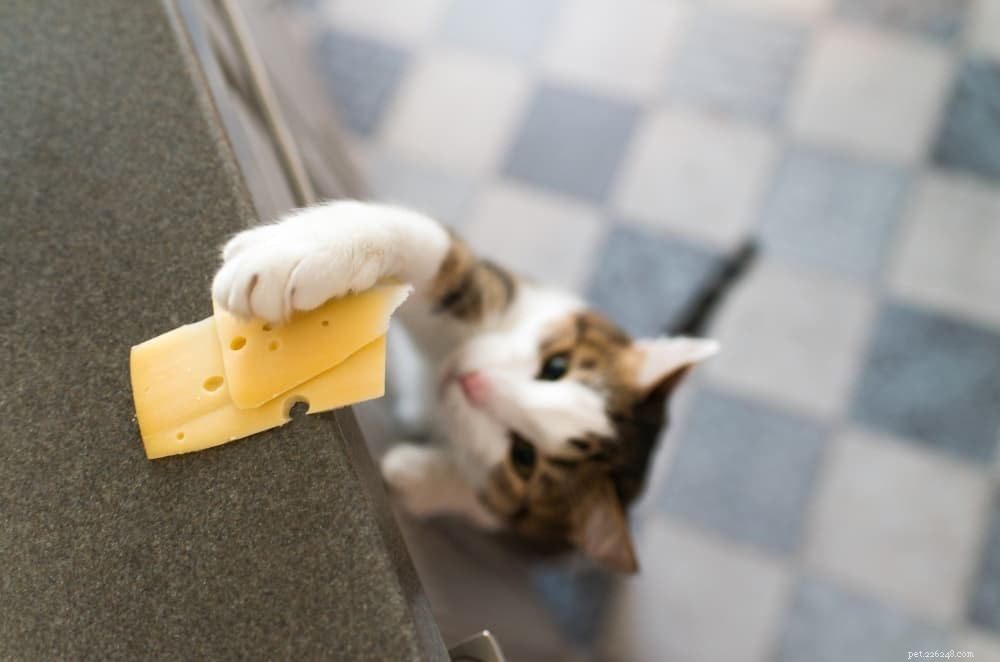
We've been led to believe for a long time that cats love milk, and even if they do, milk doesn't love them back. While some cats can eat dairy without issue, most cats show symptoms of lactose intolerance. Some cats experience gas, vomiting, or diarrhea after consuming dairy products like milk or cheese.
The good news is that not all dairy products are a no-go for cats. Find out which of your favourite dairy treats are safe to share with your kitten, and which ones may actually be beneficial.
No. At least not cow's milk. You may have heard a rumour that cats are lactose intolerant. Even though cats show signs of lactose intolerance, it's actually because the pasteurized cow's milk that we drink is missing an important enzyme, called lactase, that breaks down lactose in milk.
Goat's milk on the other hand is safe for cats to consume. In fact, raw goat's milk is an excellent digestive aid for cats. Raw goat's milk is loaded with lactase, making the lactose in the goat's milk digestible.
Goat's milk also contains a different kind of milk protein, called casein, than cow's milk. This type of milk protein is easier to digest and not linked to the same allergy and digestive issues.
While goat's milk can be fed daily, it should be done in small servings to balance with their regular diet. One tablespoon per 10 lbs of body weight is a good daily amount. A more shelf-stable option for giving your cat goat's milk is The Honest Kitchen Goat's Milk Booster. It's a powdered goat's milk that can be made in single servings at a time by simply adding water.
Technically no, but kind of. Like milk, cooked or pasteurized cheese products are going to lack the lactase needed to digest the milk sugars in cheese. So should cats eat cheese? No, but can cats eat cheese? Very sparingly.
The type of cheese can also be a factor. Hard cheeses tend to be very salty, which is not good for your cat, while super soft cheeses have higher lactose contents.
Can cats have goat cheese? Goat dairy can again be the solution to the cat-dairy conundrum. Unpasteurized goat cheese can be a safer and more digestion-friendly option for cats that love cheese as much as we do. Check out brands like Happy Days for some ready-made cat-safe goat cheese treats for dogs and cats.
Surprisingly, yes! Yogurt is made from cow's milk, but the fermentation process involved in making yogurt starts to break down the lactose into more digestible sugars. But why would cats need yogurt? Well, it turns out that yogurt is a good source of protein, calcium, and contains digestion-friendly bacteria.
Stick to plain yogurt that leaves out the fruity flavours or added sugars. The natural sugars are more than enough already. Yogurt can be fed as a daily digestive aid, but keep your portions small. One tsp per day is enough to offer the digestive benefits of probiotics.
No. Butter isn't toxic to cats, but it's most definitely not good for them either. Butter is made from cow's milk, but it's a concentration of the fat and protein in milk. It's generally low in lactose or other milk sugars, but the high-fat content can lead to digestive upsets and pancreatitis if fed in large quantities.
Even small amounts of butter can lead to your cat having a soft or runny bowel movement. Keep butter covered or tucked away in the fridge to prevent a curious cat from stealing a taste.
For the most part, very small amounts of dairy from cow's milk is not likely to cause any major issues, so an occasional piece of cheese is fine, but to be safe e and get a nutritional benefit from your cat's treats, stick to goat's milk products instead.
Goat's milk will not only satisfy your cat's dairy addiction but when used regularly as a treat or meal topper, goat's milk and goat's milk products will support your cat's digestion. Even still, small portions are key. Goat's milk should be less than 10% of your cat's daily diet to prevent overfeeding or unbalancing your cat's total nutrition.
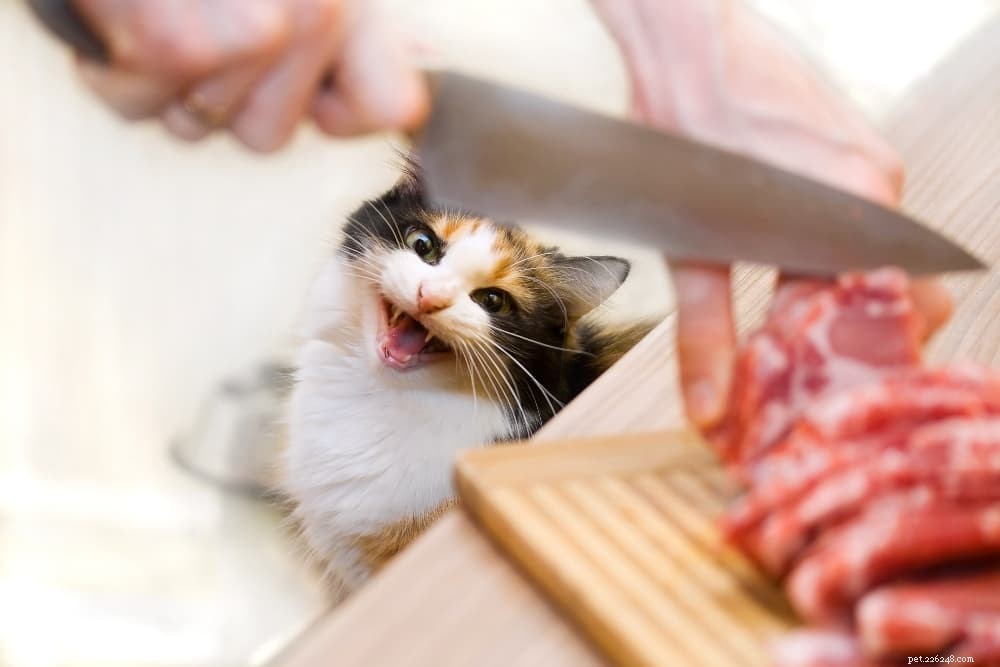
Cats thrive on a diet that includes certain meats such as chicken, beef, turkey, and duck. Meat contains the protein that cats require for a strong heart, good vision, and a robust reproductive system.
Always buy meat from a reputable source that is known for safe meat handling. If you feed meat, always wash, and sanitize the food bowls after the cat finishes dining on the meat to ensure good and safe hygiene.
Meat can be fed cooked or raw as a treat. As carnivores, cats are well suited to consuming animal protein, especially raw meat, because it is unaltered by heat that can denature or degrade nutrients. Feeding cooked meat as a treat is usually safe, so long as you skip all the seasoning and oils that you would normally use to cook meat for yourself.
Meat contains certain nutrients that are either difficult or impossible to find in plants ingredients. This is part of what makes cats carnivores. Some essential nutrients, like zinc and iron, are most abundantly sourced or most biologically available from meat.
Your carnivorous feline might not be picky about the kind of meat that you offer them, but some meats or cuts of meat might not be the ideal healthy snack for your cat.
First and foremost, stick to lean cuts of meat. While cats can handle a moderate amount of fat in their diet, excessive fat can lead to digestive issues, or even pancreatitis when fed in large quantities. Lean meats are a great way to provide long-term energy for muscle maintenance and are a desirable treat for picky cats.
Absolutely! Chicken is one of the most popular animal proteins used in commercial cat food. This is partially due to its cost and availability, but also because it's considered a biologically appropriate protein choice for cats. Wild cats often hunt birds, so your domesticated cat is well suited for digesting poultry.
Chicken can be fed either cooked or raw. If you choose to cook the chicken, skip the spices and cooking oils to keep the meat cat-safe. Breaded prepared chicken products like chicken nuggets or fried chicken are a no-go as well. Plain white chicken breast is the safest way to treat your cat with chicken.
Can cats eat chicken bones? Some pet owners give their cats bones to chew on, but you should opt for raw bones like chicken wings or necks. Cooked bones can splinter and cause injury to a cat’s gums or gastrointestinal tract. Only feed under supervision. Never leave your cat alone to chew on a bone.
Definitely! Though it's not as common an ingredient in many cat diets, beef is safe and nutritious for cats. Choosing the right cut of beef is important because beef can be very fatty in certain areas. Lean ground beef found at the grocery store typically has about 17% fat or lower which is suitable for cats.
You can cook the ground beef but make sure you leave out any spices or oils that can be harmful to your cat. This means that you can't just share your spaghetti and meatballs with your cat when she begs. The same rules apply to other kinds of beef.
A nice juicy steak may be one of your favourite ways to eat beef, but can cats eat steak too? While nutritionally, steak is fine for cats to eat, you will need to make sure that you cut the steak into small, bite-sized pieces to make sure that your cat can't choke.
Can cats eat raw beef? Cats can eat raw meat safely. While raw meat can contain bacteria that are harmful to us, your cat is built to eat raw meat and fight this bacteria in their gut. As a treat, raw meat should be fed in small pieces. Ground beef is soft and easy for your cat to chew, so it's the ideal format for cats that aren't accustomed to eating raw.
Yep! Unlike other red meats, lamb can be quite fatty. Choosing lean cuts is going to be important if you are using lamb as a treat for your cat. Ground lamb has a similar fat content to regular ground beef, so feed in moderation.
Like beef, lamb can be fed either cooked or raw safely. Lamb is a popular choice for cats with food allergies that need to avoid the most commonly used meats in cat food, like chicken and beef. If you choose chops or other whole cuts of meat, trim off any excess fat to make sure the lamb won't upset your cat's tummy.
Oh ya! This one might be surprising because, in the past, pork has been thought to carry parasites and be a generally poorer quality of meat. This is because pork is a known carrier of a parasite, called Trichinella. Fortunately, we've learned a lot about how to prevent and manage the risks of this parasite.
Firstly, thoroughly cooking pork is the way that we keep pork safe for ourselves, so cook up some pork, no spices or oils, for your kitty as a tasty treat. Feeding raw pork is also safe for cats, so long as the pork is frozen at temperatures below -15 C for at least 20 days. This is why raw pork diets for cats are becoming a popular option.
Pork can also be too fatty for cats, so make sure you stick to lean pork cuts. Ground pork can be inconsistent in its fat content, so as a treat, feed in moderation.
Much like chicken, turkey is a safe and popular meat option for cats. The fat content in turkey varies depending on the cut of meat. White meat is leaner, so look for lean ground turkey that will have more white meat and less dark. Turkey can be fed either raw or cooked to cats, just make sure you avoid any seasoning or oil during cooking.
When it comes to allergies, we often lump all poultry together, but that's not always the case. Cats with chicken allergies may not have the same reactions to turkey or other poultry, so don't discount turkey as a protein source for your cat's diet or as treats too quickly.
Avoid feeding precooked or processed turkey which is high in salt and other preservatives. This includes deli turkey or ready-made products in the freezer section of the grocery store.
Yes! Duck is an ideal source of vitamins, protein, and minerals for cats. While duck is often thought to be high in fat compared to other poultry, the majority of the excess fat is between the skin and muscle layers. If you do choose to treat your cat with a piece of duck, remove the skin and fat layer, offering only the lean muscle meat.
Duck is considered to be a novel protein, meaning it's uncommon in commercial cat diets. This is why it's often used in elimination diets for cats with suspected food allergies. Like other poultry, duck can be fed raw or cooked to your meat-loving cat.
Oh ya! Liver is just one of many animal organs that are not only safe for cats but extremely beneficial as a regular part of your cat's diet. As carnivores, cats are fully capable of getting their nutrients from animal ingredients, and liver is an especially important part of that.
Liver is loaded with iron and vitamins A, B12 and B6, and it's a flavour that cats tend to go crazy for. Liver has become very popular for cats, which is why it's easily found in cat treat formulas and as single-ingredient, freeze-dried cat treats.
Don't overdo it with liver snacks though, because vitamin A is a fat-soluble vitamin, meaning that your cat's body will start to store excess vitamin A and could lead to toxicity. Other organs like heart, kidney, and tripe are also suitable snacks for cats. Organs can be fed raw or cooked.
Many pet owners want to feed their cats an all-natural diet that consists of meat on a daily basis, and while different types of diets will offer different levels of meat inclusion, meat is one of the safest human foods to feed as a treat.
Meat is calorie-dense and filling, so don't go overboard. Meat can be fed daily as a treat or meal topper, but cut the meat into small treat-sized pieces and stick to treating only a few a day. This should be less than 10% of your cat's daily intake, so keep your portion sizes small.
Some of our favourite meaty treats are actually some of the worst things to share with your cat. Cured and heavily processed meats are filled with extra ingredients that are harmful to cats, even in small amounts. Plain, fresh meats are always the safest option. Here are a few meat products that you should never feed to your cat:
Sadly, no. Bacon is high in sodium which can lead to hypernatremia in some cats. Avoid feeding bacon or other cured meats to your cat. The high-fat content of bacon is also a concern. It could lead to digestive issues or even pancreatitis if your cat consumes enough bacon or consumes it regularly.
Probably not. Ham is also remarkably high in sodium and should be avoided. While it's not quite as risky as most cured meats, ham is still not a good treat for cats. As a very occasional treat, it is probably fine, but there are much better options for treating your cat.
No. Salami is filled with additives like salt, flavour enhancers, and artificial colourants. It contains seasonings like garlic and paprika which are toxic to cats. Salami is high in saturated fats which causes rapid weight gain in felines. Ideally, you should avoid giving your cat salami.
Can cats eat pepperoni? Double no. Pepperoni is also not good for cats because a single slice often has over 35 mg of sodium which is much too high for your cat. No matter how much your cat begs for a bite of your pizza, this is not a snack you can share.
Definitely not. Commercial jerky contains spices and prominent levels of salt. Jerky can contain garlic and onion which are both toxic to cats. Even if you make your own jerky at home and skip the spices, jerky is tough to chew and is likely a strong choking hazard for cats because of how they chew (or in this case, don't chew).
It's not recommended. Avoid feeding hot dogs due to the additives and salt. Plus the contents of a hot dog are likely to contain meat sources of unknown and questionable quality. Though hot dogs are less dangerous than cured meats, they should not be regarded as a healthy snack for cats.
Don't. Sausage contains nitrites, sodium, and excessive fat which make them a no-no for cats. Sausage may also contain garlic or onion which is toxic to cats. Even the most natural of store-bought sausages are likely to contain something that is not good for your cat.
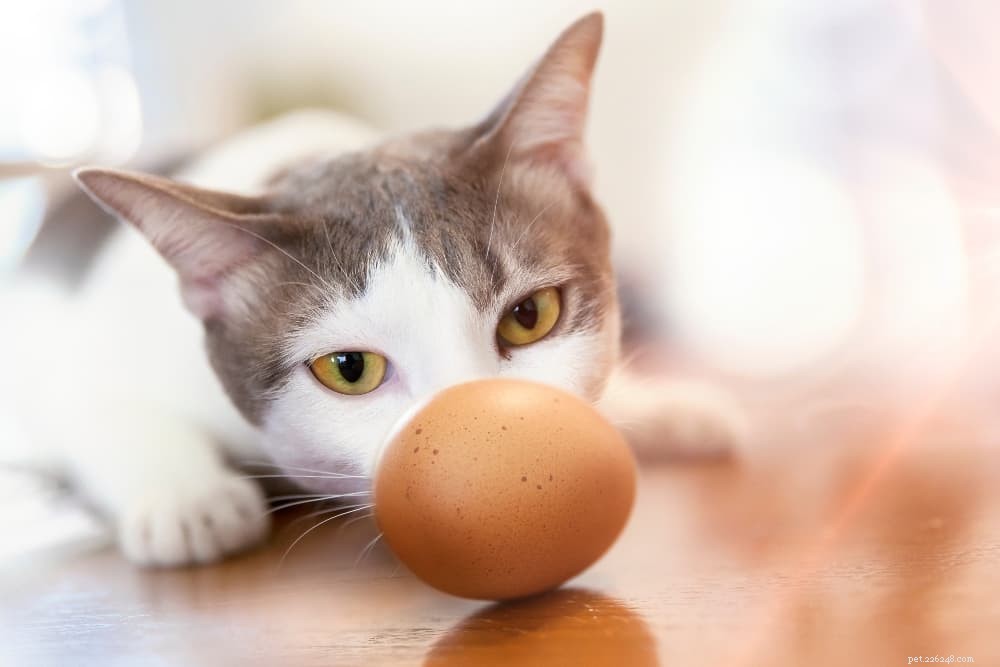
Eggs are often referred to as a superfood because they contain iron, protein, and vital minerals. Many commercial cat foods actually add eggs as a primary ingredient. Cats typically love eggs. In the wild, many cats will raid birds' nests to steal the eggs which they eat whole.
Eggs can be a great meal topper to boost protein and other nutrients in your cat's diet, or they can be a great treat if you love to offer some table scraps to your begging kitten. Just keep in mind, the eggs should be unseasoned to make sure they are safe to offer.
Eggs are packed with the following nutrients:
Eggs can be included in your pet's meals 2-4 times per week but in small portions (1 tbsp). Cooking the eggs is the safest way to feed them. Scramble the eggs without seasoning and let them cool completely before offering any to your cat.
Can cats eat raw eggs? Kan zijn. This is a hotly debated topic for a few reasons. The more well-known argument for avoiding raw eggs is the bacteria risk. Just like raw eggs for us, bacteria, like salmonella, can be present in raw eggs.
The thing to keep in mind is that eggs sold for human consumption are pasteurized, which means that are heat-treated to kill bacteria like salmonella. This isn't a guarantee though. Just like when we eat raw cookie dough, drink eggnog, or eat hollandaise sauce, the risk of consuming a raw egg product is still real.
The other argument for avoiding raw eggs is egg whites. Egg whites are high in avidin, which is a biotin inhibitor. This means that large amounts of avidin can stop your cat from digesting biotin in their food. Fortunately, egg yolks are very high in biotin, and some research suggests that this is enough to counterbalance the effects of avidin.
The nutritional difference between cooked and raw eggs for cats is minor, so if you'd prefer to play it safe, especially if you have an immune-compromised pet, then go ahead scramble and cook those eggs before serving.
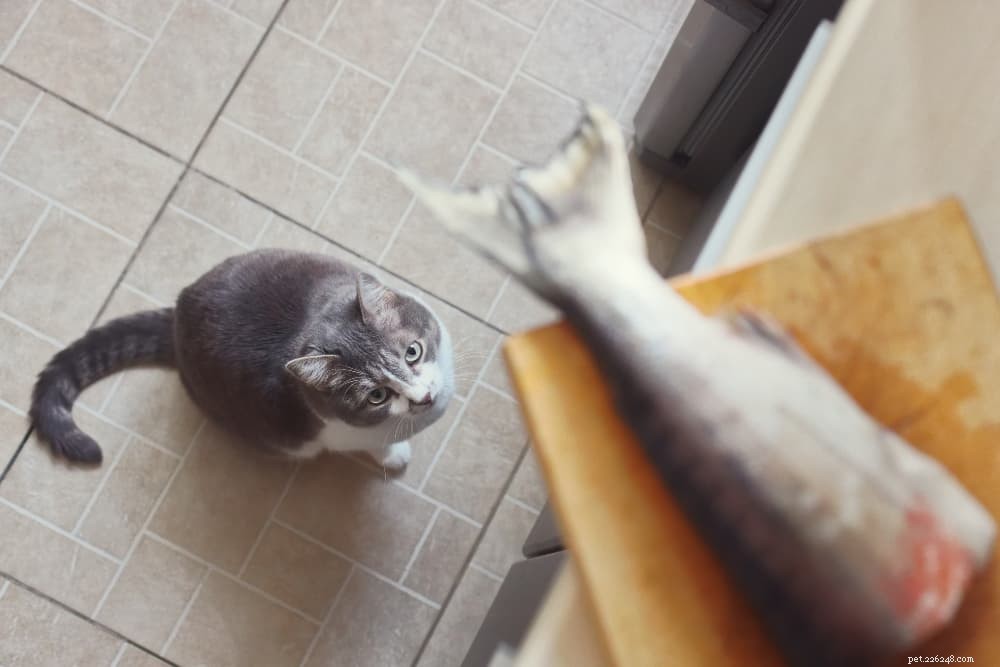
Media often portray cats as fish obsessed, and most felines do enjoy a smelly, fishy snack. Fish is an ideal food for your cat, but it should not be the pet’s sole source of protein or vitamins. Fish often lacks sufficient protein to meet a cat’s needs, plus it is deficient in key minerals and vitamins.
The omega fatty acids in fish oil offer numerous benefits for cats, like improved skin and coat, anti-inflammatory properties, better immune function. Fish are also highly palatable and can help to improve eating habits in picky cats.
Fish can be fed either cooked or raw, but be cautious of bones that could be a choking hazard. Small fish, like sardines, are fine to feed bone-in, but larger fish like salmon need to be scaled and deboned before feeding.
Many people are concerned about heavy metals in fish, like mercury. While this can be a problem, choosing the right kind of fish can make it safer to feed fish on a regular basis. The smaller the fish, the lower the mercury content. Sardines, herring, and anchovies are ideal.
Bigger fish, like salmon and tuna, can still be fed but should be less frequent and in smaller quantities to prevent mercury build-up.
Small and wild-caught fish are generally going to be the best option for treating your cat. They have a better omega 6 to 3 ratio than farmed fish because of their more natural diet. Offering your cat a small piece of your fishy dinner is probably fine, but be cautious of the extras, like oil, butter, and spices that are harmful to your cat.
Here are a few of the most common cat-safe fish, and a few less common ones:
Of Course! Cats love tuna but they can contain heavy metals so should not be consumed more than a few times per week. Some cat diets, especially canned cat foods, use tuna as a base protein. Tuna can also be a great treat if your cat is not already eating a fish-based diet, and can be fed either cooked or raw.
Don’t spoil your cat too much with tuna, though, because some cats will become obsessed with tuna and refuse other food types by going on a hunger strike. This is very common in cats that are fed canned tuna for humans. Canned tuna often contains other ingredients like salt, oil, and spices, so check the ingredient panel before you share your tuna.
Oh ya! Similar to tuna, salmon can also be a great snack for kitties. Canned salmon is likely to contain salt, spices, or preservatives, so fresh-cooked salmon is ideal, just make sure to skip the seasonings.
Raw salmon can also be fed as a treat, but less frequently. Raw salmon, like all fish, contain an enzyme called thiaminase, that breaks down thiamine, an essential B vitamin. When fed regularly and in large quantities, can lead to thiamine deficiency in your cat. Cooking the fish destroys the enzyme, making it safer to feed fish more regularly.
If your cat is not a huge fan of fish, which may seem odd, but isn't that uncommon, you can still offer her valuable nutrients from salmon oil, or other fish oils. They have a milder flavour and are easy to add to your cat's dinner unnoticed.
Definitely! Sardines are one of the best fishy treats for cats because they are high in EPA and DHA, two omega 3 fatty acids that are beneficial for growth and cognitive function. Additionally, sardines are a more sustainable fish, meaning they are not overfished, like larger fish that are popular in human cuisine.
Canned sardines are one option for treating your cat, but be cautious of what else is in the can. Oils, salt, and other seasonings are not good for cats. 1-2 fresh sardines per week is safe, and they can even be fed raw. Whole small sardines make a great treat for cats that love to chew, but freeze-dried sardines are a less messy choice to protect your furniture and carpets from raw fish juices.
Yes, but fresh only. Anchovies for people often come canned and heavily salted or in brine. These are a definite no-go for cats. Fresh anchovies are the only safe option for cats.
As a smaller fish, anchovies are much more sustainably sourced and have lower mercury and heavy metal content than larger fish, so they can be fed more frequently as a treat or as a meal topper to boost your cat's nutrition. 1-2 small anchovies per day if fine as a treat, so long as your cat isn't already eating a fish-heavy diet.
Cats love fish for the taste, and we love fish for the health benefits, but what about the other creatures of the sea. Are the rest of our favourite ocean delicacies safe for cats too?
The good news is that lots of them are. Though you may not be eating many of these fancy dishes every week, it's good to know which ones you can offer your cat a taste of whenever you do splurge on a seafood dinner. Like with fish, seafood is safest when cooked without spices or oils. Boiling the seafood in plain water is the best way to prepare seafood for your cat.
Here are some of our favourite cat-safe sea creatures:
They can, though they may not like the texture. Squid isn't for everyone, especially without the breading and dipping sauce that your cat can't have. The chewy texture might be off-putting for some cats.
Shrimp and prawns are one of the more affordable seafood options for humans, but they can be a tasty snack for cats too. Boiling the shrimp is the safest way to cook them for cats because you can easily skip any oils or butter that are often used in frying. Absolutely no tempura or other deep-fried shrimp.
Lots of shellfish are cat-safe and nutrient-dense. Make sure that shells should always be removed and the shellfish should be boiled for safety. Popular cat-safe shellfish include crab, lobster, clams, scallops, and mussels. Skip the typical toppings and dips though. No butter, seafood sauce, garlic, or hot sauce for cats.
Fish can be part of your cat's regular diet, but most are best fed as an occasional treat. 2-3 times per week is safe for most fish and other seafood so long as the portion you feed isn't more than 10% of your pet's total food for the day.
Feeding fish as a treat is best if your cat is not already eating a diet that is rich in fish. Some fish, like anchovies, can be fed more frequently, but don't let your cat's fishy treat unbalance their regular diet. Remember that you are just supplementing, so small portions.
Feeding fish oils daily is a good option for cats who don't need the extra calories of eating fish as treats. Fish oils can be helpful in reducing inflammation, conditioning skin and coat, improving digestion, and supporting your cat's development as they age.
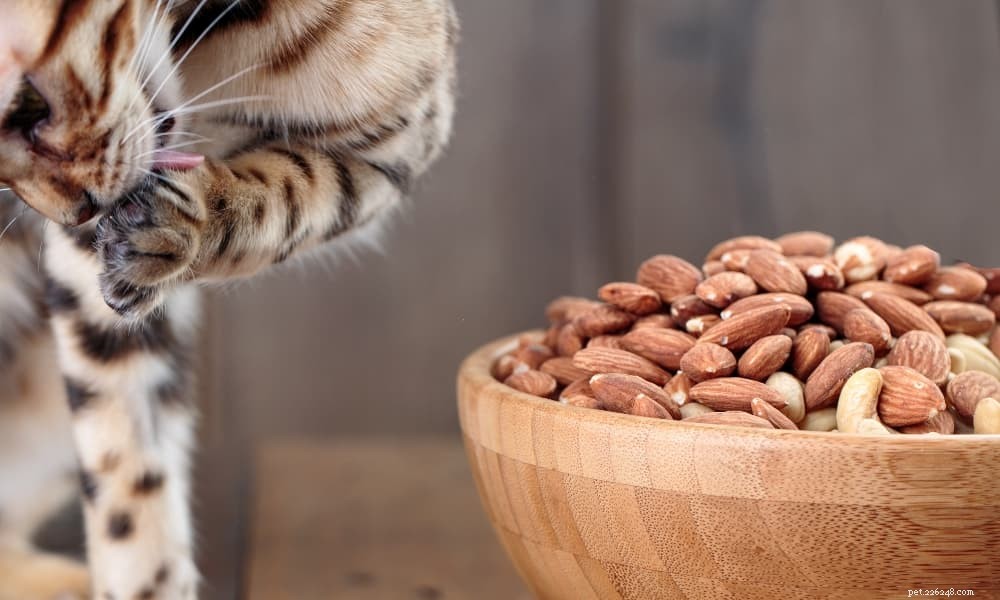
They can! This one might seem odd because you wouldn't think of nuts as a common ingredient in your cat's diet, but nuts can offer beneficial nutrients and in certain raw diets, help to properly round out the nutrition of the diet. Nuts might just be a tasty snack for you, but they are loaded with healthy fatty acids, fibre, and fats that your cat's body can use as energy.
That being said, too much fat can be an issue for cats, so nuts should be an occasional snack that is fed in small portions. Avoid salted and seasoned nuts, and always remove the shells.
The best way to feed nuts, much like seeds, is to soak them overnight to remove anti-nutrients like phytic acid and grind them to make them easy to digest. Whole nuts can easily be a choking hazard for a cat and will be harder to digest if they are not chewed.
Many of the most common nuts are safe for cats, but there are a few that are toxic. Make sure you know which nuts to avoid feeding your cat. Nuts are high in fat, so even those that are non-toxic and nutritionally beneficial need to be fed in small amounts to prevent digestive issues or more severe problems.
Yep! Peanuts are high in protein, potassium, phosphorus, and magnesium help to support your cat's bone health, and the high, but healthy, fats can provide an energy boost for active cats.
Can cats eat peanut butter? They can, but natural is always best. Peanut butter can have lots of extra ingredients like sugars, or worse, toxic artificial sweeteners like xylitol. Stick to plain, natural, single-ingredient peanut butter.
Absolutely! Almonds are a great source of protein, magnesium, and copper. Adding nuts to your cat's meals can boost fibre too, which can help your cat feel fuller for longer, which is great for cats that need to lose some weight.
They can! Cashews offer similar vitamins and minerals to almonds, but also contain types of antioxidants that can help reduce inflammation. The fat in cashews helps provide energy for the brain and body.
Yup. Pecans are the dessert nut, so when you want to give your cat a "sweet" treat, pecans are a great way to do so. Pecans are very high in fat, even compared to other nuts on our list, so you need to stick to small portions and only as an occasional treat. The high fibre content of pecans can help with digestion and weight loss too.
Nuts are high in fatty acids, vitamins, and minerals that are all beneficial for your cat, and even though several nuts are safe for cats to eat, you need to be very careful about how they are prepared.
Nuts need to be shelled and unsalted or unseasoned, but feeding whole shelled nuts can still pose a choking risk. It's best to grind or chop them finely and use them to sprinkle over their meals.
Additionally, nuts contain phytic acid which is an antinutrient, meaning it prevents other nutrients from being digested. To remove the phytic acid, the nuts should be soaked overnight and drained and dried before being ground.
Some nuts are toxic for cats, like walnuts, so stick to only cat-safe nuts, and feed in small portions. Nuts can be fed as a treat or make a great dietary booster. 1/4-1/2 tsp per day, a few times per week can add flavour and nutrients to your cat's diet. Other cat-safe nuts include brazil nuts, pine nuts, and pistachios.
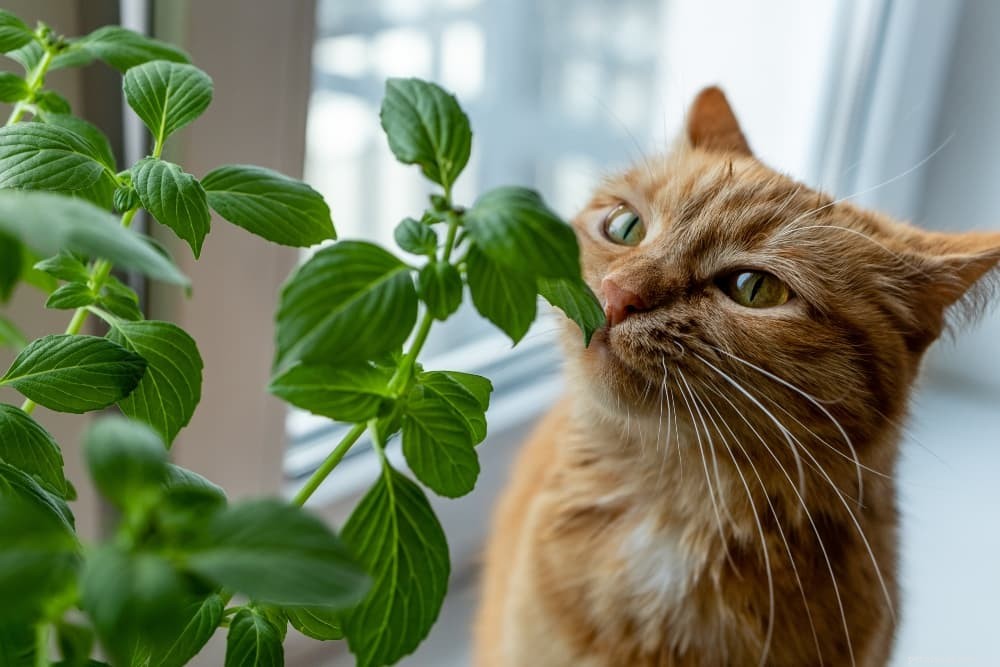
We like to use spices, herbs, and sweeteners to make our food more palatable, but you may not know that many of these aromatic and flavourful food additives actually offer some health benefits as well.
Of course, your cat doesn't need the flavour additives when they are eating a high-quality, meat-rich diet, but you may find that some of these cat-safe spices and condiments are actually quite good for them.
Not many spices are cat-friendly. Some are toxic, while others are an unpleasant smell or taste for cats and might make your cat turn her nose up at her spiced-up dinner. check out two spices that can be used to boost your cat's health.
Yes. This one is technically a vegetable, but you most likely use it as a spice in your cooking. Ginger has many health benefits, and because it's non-toxic, you can use ginger as a meal additive to help support your cat's health. The most well-known benefit of ginger is its anti-nauseant properties. It can be used in combination with digestive aids to help soothe your cat's tummy, like Fruitables SuperBlend Supplement.
Additionally, it contains anti-bacterial, anti-viral, and anti-inflammatory properties that can help to support digestive issues, skin and coat issues, and even joint and mobility problems. Ginger is potent, so your cat won't need much. A little goes a long way, and this "spice" has a potent flavour and aroma, so 1/8 tsp is plenty to add to your cat's meal.
In small doses. Cinnamon isn't considered toxic for cats but can be an irritant when your cat is exposed to large quantities. Consuming very small amounts of cinnamon is unlikely to be an issue, but large doses, inhalation, and even skin contact can be irritating for cats.
Cinnamon does have some benefits though, most popular is its antibacterial and anti-inflammatory properties that can help to soothe digestive issues and improve nutrient digestions.
All in all, keep cinnamon, including cinnamon sticks and cinnamon essential oils, out of reach from your cat. If you choose to feed cinnamon for its digestive benefits, then add just a sprinkle (1/16 to 1/8 tsp).
When you think of snacks for yourself, you might crave something sweet. A few drops of honey in your tea or a drizzle of maple syrup in your oatmeal are a great way to take a boring treat and make it special, but can you use sweeteners to spruce up your cat's meals too?
In general, we don't recommend sweetening your cat's food or treats. Partially because cats don't have a preference for sugar or sweet tastes, so what's the point, but mostly because sugary ingredients will cause digestive issues. Sugars feed gut bacteria and can quickly lead to some uncomfortable digestive reactions.
That being said, some naturally sweet ingredients can have some beneficial properties for your cat.
Yes, but they shouldn't. Sugar is a quick source of energy, but it's often more than your cat will use. This can lead to weight gain. Even more, excess sugar feeds bacteria in your cat's gut which can cause digestive issues. All in all, sugary foods should be avoided for cats.
Other very sugary foods, like maple syrup and molasses, are not toxic either, but they still offer way more sugar than your cat is built to handle. You may see them as an ingredient in some cat treats (more often in dog treats), but they will be extremely small quantities. It's best to avoid these sweeteners for cats.
Yes, but sparingly. Honey is sometimes used in specialty cat treats, and in small doses it's safe. Raw honey has many helpful properties, like as an anti-bacterial and anti-fungal remedy, and is a good source of antioxidants, but the typical honey we use to sweeten our tea is pasteurized and doesn't offer the same benefits.
If you do feed honey to your cat for its healing or immune-boosting properties, stick to raw Manuka honey and only feed in very small quantities - 1/4 - 1/2 tsp per 10lbs of body weight mixed with their food.
We use many herbs to flavour our food, and while they do contain essential oils that can have health benefits, cats don't benefit the same way because they are difficult to digest due to their carnivorous digestive system. Lots of herbs are non-toxic for cats, so if you grow your own herbs, your cat may be curious enough to give them a try, so it's important to know which ones are safe to leave out for your cat to nibble.
Find out which herbs are safe for cats to eat, and if there is any nutritional benefits to feeding them.
Yep! Basil is totally non-toxic for cats, so if your cat likes to sample your indoor herb garden, then don't fret. Basil contains a very aromatic essential oil, and it can act as a repellant for cats, but some cats are just too curious to care about the smell.
They can! Another potent smelling herb, cilantro is not likely to be your cat's favourite snack, but if she is willing to give it a nibble, then don't fret. Cilantro does offer small amounts of vitamins and minerals, but not enough to be used as an effective nutritional aid.
It's not recommended. Cats are often attracted to the scent of mint because of its similarity to catnip, a member of the mint family. Garden mint contains peppermint oil which can be toxic in large quantities. A small amount of mint may only cause minor irritation, but if your cat is chowing down on fresh mint, or concentrated essential oils, you will have big digestive problems.
If you grow your own mint, make sure you keep it out of reach of your kitty. Instead, make sure you have some catnip on hand to give your cat a much safer, and funner alternative. To find out more, check out our Ultimate Catnip Guide.
Oh ya! This is one of the rare herbs that can actually be beneficial for cats, but not in the way that you'd think. Parsley has natural antibacterial properties that can be an effective breath freshener for cats. Adding a small chopped-up sprig to your cat's food can help ditch that kitty breath and improve dental health.
This dental trick will not replace regular dental care habits, like brushing your cat's teeth, but can still be helpful. It is also a natural diuretic, which can help support urinary care health by increasing urination and flushing out unwanted bacteria from the urinary tract.
Cats are typically drawn towards green leafy herbs, and while there are some cat-safe herbs, like the ones above, but most don't fill any nutritional need for cats, so feeding them as treats or meal toppers isn't necessary or an effective way to boost your cat's health.
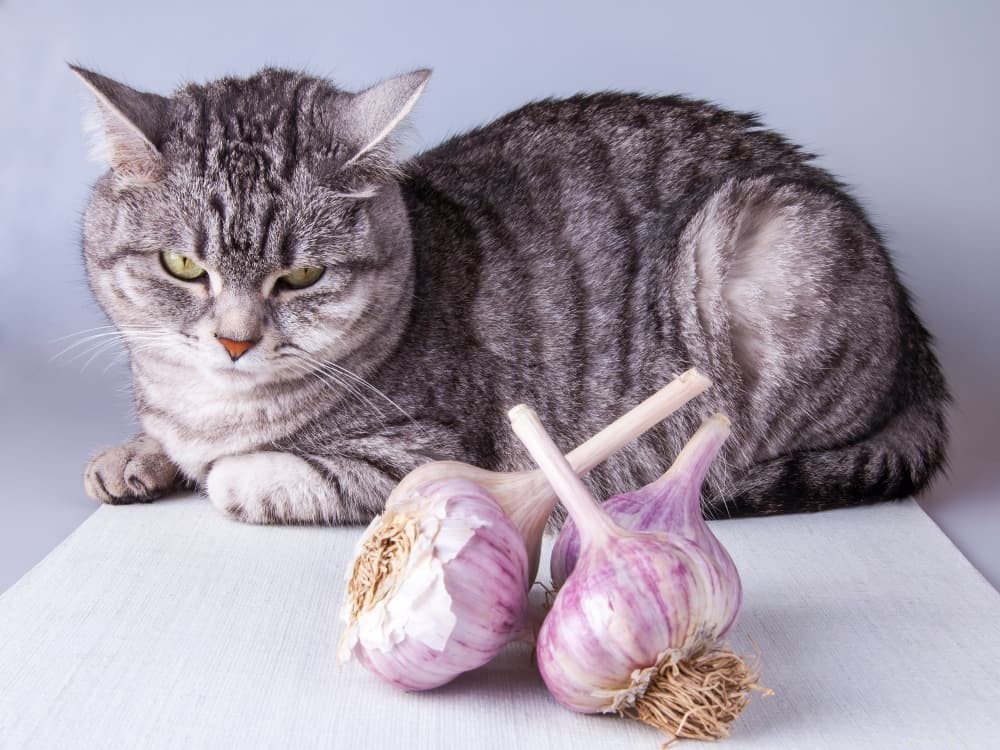
Fresh ingredients are a great way to help boost your cat's overall nutrition, and while there are many human foods that are safe and nutritious for cats, but there are many that are highly toxic and should never be fed to your kitty. Take a look at some of our favourite foods that are toxic for your kitty.
Definitely not! While chocolate is one of the ultimate human treats, it's not safe for your cat. Chocolate of all kinds contains theobromine. Cats (and dogs) are very sensitive to the effects of theobromine. In humans, it acts as a mild stimulant, but for your cat is can lead to intense digestive issues, seizures and even death if your cat eats enough of it.
The darker and purer the chocolate, the more theobromine is present. Dark chocolate could have 3-4 times the levels of bromine than milk chocolate, but no matter how potent, all chocolate should be avoided for cats. If you really want to give your cat a sweet treat for a special holiday, then stick to small amounts of carob instead.
Obviously not! Alcohol, in any form, is very dangerous for cats (and dogs!). Ethyl alcohol can cause your cat's central nervous system to slow down and could cause respiratory distress. Never, ever, ever offer your cat any booze, beer, or spirits of any kind.
Rubbing alcohol and other products, like cleaners and hand sanitizers, contain a different kind of alcohol, called isopropyl alcohol. These are even more dangerous for cats, so make sure you keep your cleaning agents out of reach of your kitty.
Absolutely not! This is one of the more well-known toxic foods for cats. The strange thing is that we don't totally know why grapes, raisins, and currants are toxic for cats (and dogs). All we know is that damage is done to the kidneys.
There is speculation that it could be mycotoxins or naturally found compounds that could decrease blood flow to the kidneys, but to date, we just don't know. What we do know is that grapes should never be fed to dogs and cats.
So no grapes, but can cats eat raisins? Still nope. Though dried and shrivelled, raisins are still just as toxic as grapes, so keep them out of reach. This also goes for sultanas and currants, too.
Reactions to grape poisoning vary on an individual basis, so even though some pets can sneak a grape or two without consequence, others may suffer reactions from even a small amount of this toxic fruit and its cousins.
No. No matter how many vitamins citrus fruits may have, you should not offer your cat a taste of these sour and acidic fruits. The natural essential oils in many citrus fruits, like lemon, are toxic to cats. Symptoms of citrus poisoning include vomiting, digestive distress, weakness, and even skin reactions.
Citrus fruits that you should steer clear of offering your cat include lemon, lime, grapefruit, and oranges. If your cat accidentally sneaks a taste of some citrus fruit or juice, the chances are the reaction will be mild, but you should monitor them for worsening symptoms. Never give your cat citrus fruits.
It's not recommended. There is a lot of questions about whether or not garlic, in small doses, is harmful to cats. While we know that dogs can benefit from small doses of garlic, but what about cats? The truth is garlic may be beneficial to cats, but can still be dangerous if you feed too much.
In general, feeding garlic to your cat is not recommended, but it won't do your cat immediate harm if she steals a small nibble of food that contains garlic. Even if your cat can tolerate small amounts of garlic, chances are the small dose would provide fewer health benefits than using other cat-safe supplements.
Newp! In the same allium plant family as garlic, onions are toxic to cats. This also includes shallots and leeks. Though tiny amounts of onion are likely not going to be harmful to your cat if she happens to sneak a taste, there is no nutritional benefit from onion, so why take the risk.
Onions are a common ingredient in many sauces and premade foods that you may eat, so be mindful of any foods you share with your cat.
Never. Some of our favourite unhealthy snacks, like chips, candy, ice cream, and soda are especially bad for your cat. There are a number of dangerous ingredients that are used in these packaged goods, like sugar, salt, garlic, and artificial ingredients.
Any human foods you feed your cat should be healthy and natural. Anything heavily processed is guaranteed to have something bad for your cat, so absolutely no sharing.
While toxicity and digestive reactions may vary depending on the potency of the ingredient and your unique pet, you should never, ever, intentionally feed your cat foods that are known toxins. If your cat ever accidentally ingests (or steals) a bite of one of these toxic foods, you should monitor their behaviour and digestion for the next 24 hours for any issues, and call your vet immediately if your cat has ingested large quantities of them.
Now that you know which of your snacks and favourite foods are safe to share with your feline friend and which ones should be avoided, you can start to boost your cat's nutrition with some fresh ingredients, or just spruce up her treat routine.
Fresh ingredients are a great way to boost your cat's nutrition, but everything in moderation. If you are feeding a high-quality cat diet already, then adding additional fresh ingredients isn't required, but can still be beneficial.
Cats enjoy a varied diet so adding cat-safe human foods not only offers nutritional benefits but also gives the kitty something to look forward to each meal. You can add a little human food mixed with quality commercial cat foods to ensure you are meeting all of your cat’s dietary needs.
If you only offer table scraps and human foods for flavour, be cautious of how dependant your cat may become on those flavourful additions. You may find that your cat starts to develop some picky eating habits if she's been too spoiled with yummy extras.
If you find your cat is getting addicted, then stop giving human foods as meal toppers entirely, and limit treats to specific reasons, like rewards for training or chewing and dental health.
What is your cat's favourite human food? Let us know in the comments below!